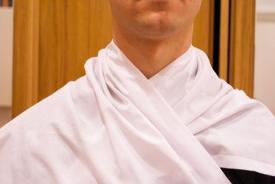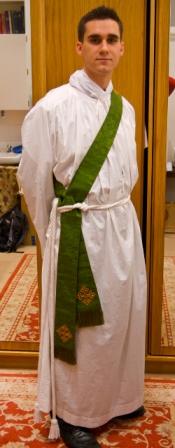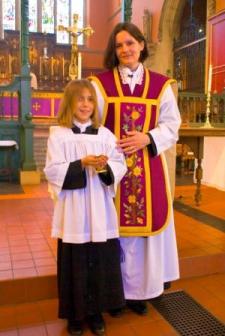
Vestments
The Master of Ceremonies, Cathie James, explains what you see in the sanctuary.
Do you ever wonder about what the clergy at St Michael’s wear for Mass and why?
Vestments, as they are collectively called, have their origin in the ordinary clothes of the first century. They have now taken on a symbolic meaning reminding us of the tradition of our faith and the changeless focus of our worship. Vestments confer an anonymity on the priests that focuses the worshipper on the significance of liturgy and away from the particulars of the individual.
What do priests wear for Mass?
Worn over their black cassock are: The amice, the alb, the stole, the girdle and the chasuble. These garments are laid out before each Mass in the Sacristy by the Sacristan (Anne Mower) in this way:
Firstly, the chasuble, then the stole in the shape of an Alpha (Christ is the beginning)
Next is the girdle in the shape of an Omega (Christ is the end of all things)
The alb is the laid on top of these and then the amice over all with its tapes folded in the shape of St Andrew’s cross.
 What is an amice? This is a rectangular piece of cotton or linen cloth worn around the neck and shoulders under the alb with strings at the upper corners by which it is attached round the body. Its name derives from the Latin verb ‘amicire’ meaning ‘to wrap around’.
What is an amice? This is a rectangular piece of cotton or linen cloth worn around the neck and shoulders under the alb with strings at the upper corners by which it is attached round the body. Its name derives from the Latin verb ‘amicire’ meaning ‘to wrap around’.
 What is an alb? This is a full length white garment symbolic of the white robes worn by the elect as described in Revelation 7:9-10 and at all baptisms and confirmations. The alb was the ordinary dress of a Roman citizen its name derives from the Latin word ‘alba’ meaning ‘white’. It signifies purity and new life. A plain alb is used for Mass in ordinary time, Lent, and Advent but more ornate albs with lace trim are worn for Feasts (such as Easter and Christmas) and Festivals
What is an alb? This is a full length white garment symbolic of the white robes worn by the elect as described in Revelation 7:9-10 and at all baptisms and confirmations. The alb was the ordinary dress of a Roman citizen its name derives from the Latin word ‘alba’ meaning ‘white’. It signifies purity and new life. A plain alb is used for Mass in ordinary time, Lent, and Advent but more ornate albs with lace trim are worn for Feasts (such as Easter and Christmas) and Festivals
What is a girdle? The girdle is used to secure the alb and is tied around the waist – it is made of rope or cord and may be the liturgical colour of the day (see later).
What is the stole? This is a long strip of rich fabric that is worn by both priests and deacons. It is given to them at their ordination and is a sign of their sacramental and teaching authority. It is worn both for the Eucharist and other sacramental services. A priest wears the stole round the back of the neck with the two ends of matching length at the front. (A deacon wears a stole across the left shoulder, tied at the right hip – observe our previous curate Father Stephen, above). It symbolises service; Christ washing the disciples feet with a towel. The stole worn at Mass matches the liturgical colour of the day.
 What is a chasuble? This is the outer garment of the priest at the Eucharist. Originally it was a cloak rather like a ‘poncho’ but has evolved over the centuries into different shapes all donned through a central opening for the head. The two types of chasuble commonly worn at St Michael’s are the rather fuller ‘Gothic’ and the narrower ‘ Roman’. The chasuble represents the charity of Christ which ‘covers all things’. It is usually made of silk or a similar rich fabric with skilled workmanship and beautiful decoration as befits its symbolic meaning. Its name derives from the Latin ‘casula’ meaning ‘little house’ as it ‘covered all’.
What is a chasuble? This is the outer garment of the priest at the Eucharist. Originally it was a cloak rather like a ‘poncho’ but has evolved over the centuries into different shapes all donned through a central opening for the head. The two types of chasuble commonly worn at St Michael’s are the rather fuller ‘Gothic’ and the narrower ‘ Roman’. The chasuble represents the charity of Christ which ‘covers all things’. It is usually made of silk or a similar rich fabric with skilled workmanship and beautiful decoration as befits its symbolic meaning. Its name derives from the Latin ‘casula’ meaning ‘little house’ as it ‘covered all’.
As each vestment is put on the priest says a prayer describing the symbolism of each garment, culminating in placement of the chasuble with the words: "O Lord, you have said: My yoke is easy and my burden is light. Enable me to bear it so that I may obtain grace."
Why does the colour of the vestments vary?
Specific colours have come to be used for vestments and church hangings within the context of the Christian year. They all have symbolic meaning and association with particular seasons, feasts or saints days.
Gold (glory and resurrection) – major Festivals such as Easter or Christmas
White (joy and celebration) – Feasts of Saints and Our Lady, the Sundays of Christmas and Easter etc. and also weddings and baptisms
Red (Holy Spirit and the blood of martyrdom) – Palm Sunday and Good Friday, Feasts of apostles and martyr saints, Pentecost
Purple/Violet (penance and mourning) – Advent and Lent, some Requiem masses and alternative for Remembrance Sunday
Black (mourning) - some Requiem Masses, All Souls Day and Remembrance Sunday (so look out for black vestments during the month of November )
Rose (subdued joy) – third Sunday of Advent and fourth Sunday of Lent (Mothering Sunday)
Green (hope and fidelity) - Ordinary time (Sundays after Trinity)
So next time you are at Mass - note the colour of the clergy’s vestments and link it to its symbolic meaning.
If you are interested to see or know more about clergy vestments then Anne Mower would be very happy to show them to you in the Sacristy.